Today, I am reviewing a unique Phil Barone Hollywood 8 tenor saxophone mouthpiece that I had Keith Bradbury (Mojobari) work on for me a number of years ago. I had originally bought this from a sax player who said it was his gigging mouthpiece for a number of years. The bite plate had some deep teeth marks in it that made it uncomfortable for me to play so I sent it to Keith Bradbury to have the bite plate replaced. I have had Keith repair a number of bite plates for me over the years and he always does a great job at a reasonable price so I felt comfortable sending this sax mouthpiece to him. As long as I was sending it to Keith for the bite plate, I also decided to have him do some other work on the mouthpiece also.
First of all, for some reason this Barone Hollywood mouthpiece was incredibly tight on my saxophone neck cork. I have had and still have many Barone mouthpieces in my collection and many of them have been quite snug on the neck cork but this Hollywood mouthpiece was super tight! Every time I tried to use it, it would completely squash my cork down so any other sax mouthpiece would no longer fit on the cork. I asked Keith if he could expand out the bore to be more of an average sized mouthpiece bore like a typical metal Florida Otto Link. I asked that he only do this for the first 3/4 of an inch into the shank because that is where the mouthpiece needed to be to be in tune and I didn’t want more of the bore taken away as that might change the chamber size and sound.
Barone Hollywood 8 Tenor Sax Mouthpiece Refaced by MojoBari
I also got a bit more adventurous by asking Keith to put a facing curve on this Hollywood mouthpiece that would match the facing curve of my Jon Van Wie refaced Otto Link mouthpiece (Here is Jon Van Wie’s description of this mouthpiece in his own words). I had bought the JVW metal Link mouthpiece years ago and it was my main gigging saxophone mouthpiece for many years. JVW had refaced this modern metal Otto Link and put his own baffle into it before I bought it and the JVW Link had what I thought of as a perfect blend of a jazzy traditional (although brighter….) Otto Link sound with the ability to get a convincing modern Brecker type sound out of it. I noticed that the Barone Hollywood mouthpiece baffle was similar in size and shape to my JVW mouthpiece baffle so I wanted to see if it would play similarly on my saxophone if it had a similar facing curve.
The main reason for wanting to do this is that I have had multiple surgeries on my brain over the years and had a hard time playing the same 3 1/2 saxophone reeds I use to use throughout the 90’s. I would get excruciating headaches when trying to play those harder reeds on my sax. (Turns out that I had elevated intracranial pressure in my head but that is a different story…….) The JVW Link mouthpiece played with loads of power with a Green box Vandoren Java 2 1/2 saxophone reed. It was easy for me to play and I didn’t feel like I had to blow my brains out to get the volume I needed on my sax. If I could get the Barone Hollywood mouthpiece to play like that also then I would have two sax mouthpieces I could choose from.
This was a bit of a gamble though. The JVW Otto Link mouthpiece had a unique curve on it. First, it was a shorter curve of 48, but secondly it also had a steeper curve at one point in comparison to most traditional tenor saxophone mouthpiece curves. My theory was that this steeper part of the curve would make softer reeds feel harder and more resistant as the reed had to bend over that steeper section of the curve. The strange thing about the JVW Link mouthpiece is that the only saxophone reeds I had found to work well on it for me were Green Vandoren Java 2 1/2 saxophone reeds. That is it. Every other saxophone reed was too stiff, too harsh, too edgy, too stuffy, etc…….You get the point, but put a Java 2 1/2 saxophone reed on and the JVW Link mouthpiece could wail! I have no doubt that the reason behind this was that original JVW mouthpiece facing curve. Put that same 2 1/2 java saxophone reed on most other sax mouthpieces and it would feel like a wet noodle. On the JVW Otto Link mouthpiece it was perfect!
Barone Hollywood 8 Tenor Sax Mouthpiece Refaced by MojoBari
To be honest, I did detect some resistance from Keith Bradbury about putting the JVW curve on the Barone Hollywood mouthpiece. In fact, I had another mouthpiece maker put a similar curve on another Otto Link years before this and he had the same reservations. I would receive emails like “Are you sure?” “This curve is not the best.” “This curve is not optimal.” “There will be a lot of resistance with this curve….” “Are you sure?” etc…….Keith basically made similar statements and asked similar questions as these but after I reassured him he said “Ok, if that is what you like, lets go for it…..”
In the end, it turned out that although Keith Bradbury got close to copying the JVW facing curve he couldn’t copy the curve exactly. From what I understand, to get it exactly, he would have had to close the mouthpiece down and then open it back up but there was not enough material at the tip to accommodate that much work on the mouthpiece. The curve was close, but in the end, was not the exact curve as my JVW Otto Link mouthpiece. I had to except it, nothing more could be done.
Barone Hollywood 8 Tenor Sax Mouthpiece Refaced by MojoBari
When I received the Barone Hollywood mouthpiece back and first tried it, I found it to be very bright, brittle, and edgy sounding. I did not like it at all! Keith had done a great job on the bite plate and the shank resizing but playing the mouthpiece was just over the top bright and edgy for me. I must admit that I was a bit disappointed. I sadly put the Barone Hollywood mouthpiece in the back of my mouthpiece drawer. That was more than three years ago. It sat in the back of my drawer for 3+ years silently biding it’s time…………..
A couple of days ago, I saw the Barone Hollywood mouthpiece hiding in the back of my drawer and decided to give it another run. I wiped the dust off of it, put a used Vandoren Java 2 1/2 on it (I am all out of new Vandoren Java reeds and am too cheap to buy more…….), put the Hollywood on my saxophone and played. My first reaction was that the tone was still really bright and edgy but then I thought about my JVW Otto Link mouthpiece and how bright and edgy that can be when I first play it when coming from a different saxophone mouthpiece. It can be obnoxiously bright when you come right from another mouthpiece but after I play it for a little bit the JVW mouthpiece warms right up!
I decided to spend some more time with the Barone Hollywood mouthpiece and see what would happen. Sure enough, it smoothed out and fattened up for me just like the JVW mouthpiece does within 10-15 minutes. I know that nothing related to the mouthpiece is changing during those 15 minutes, but it sure does feel like it. I think while I am playing, I am making slight alterations which are affecting how the mouthpiece sounds and responds. The main adjustments that I am conscious of are: 1.) I tend to fatten up my bottom lip and 2.) I blow what seems like a fatter fuller column of air.
The fatter bottom lip seems to dull the edge and take some of the brightness out of the tone and the stronger fatter air stream makes the tone sound fatter and smoother to my ear. Obviously, I am not sure my air column actually gets fatter but I use that word because when I play this way I feel like my neck and throat area puff out more. I tend to do these two things on every high baffle saxophone mouthpiece I play for the same reasons I have just listed.
Barone Hollywood 8 Tenor Sax Mouthpiece Refaced by MojoBari
The refaced Barone Hollywood is definitely on the brighter side of saxophone tone as you can hear in the clips below. Like my JVW Link mouthpiece, I find that if I play at a soft to medium volume I can get a respectable Otto Link tone out of the Barone Hollywood mouthpiece. When I push the air through the mouthpiece faster, it is hard to keep that brightness and volume in check though. It kind of kicks into overdrive at about 60% air flow and at 90% air flow I think it can rip the roof off a mobile home if pointed in that direction.
Keith Bradbury must have gotten close enough to the JVW mouthpiece curve because the Java 2 1/2 reed felt great on the refaced Barone Hollywood mouthpiece. I played it for a few hours. It was easy enough for me to play and blow and there was just enough resistance to blow against that I could easily shape and mold the tone as I played without giving myself a headache.
As a side note, I did notice that the refaced Barone Hollywood mouthpiece was easy to push into that coarse split tone saxophone affect. You can hear it a few times on the demo below. Most of the time, it was unintentional on my part. I would play a note with full air and get that raspy split tone effect easily. Usually when I got it, I would play the note again to see if I could get rid of it and I always could so it must be related to something I was doing but as of this point I am not exactly sure what I was doing to cause it or if I can make it happen on cue. The split tone definitely is easier to get than on most of the other sax mouthpieces I have reviewed so maybe it is something to do with the baffle, soft reed and how I am playing. Regardless of all that, I really like the affect and think it sounds pretty tough sounding………
Barone Hollywood 8 Tenor Sax Mouthpiece Refaced by MojoBari
Keith did excellent work on the Barone Hollywood tip rail as it matches the reeds exactly. He also nailed the bore enlargement as it slides on the cork with the perfect amount of tightness. As you can see from the pics, he also did a great job with replacing the white bite plate .
Barone Hollywood 8 Tenor Sax Mouthpiece Refaced by MojoBari
On the sound clips below, I try to give a good range and variety of sounds and textures so that you can hear the mouthpiece perform in different styles. I do tend to lean towards the louder funkier altissimo lines but I think that is the nature of the mouthpiece and it kind of pulls me in that direction. As usual, I have included one clip that has reverb so you can get an idea of how the mouthpiece would sound in a large room like your garage and a clip that is dry so you can hear how it would sound if you practiced in your bedroom closet (I’ve had to do that in the past….Haha!)
The altissimo is easy to play and the mouthpiece can really scream up in the altissimo range when you really push it. At the same time, you can hear me back off the volume a little bit and hear how the lines mellow out and normalize a bit.
Part of what I love most about the JVW Link mouthpiece is it’s incredibly focused tone. The refaced Barone Hollywood mouthpiece has that same concentrated focus also. It is not spread in tone at all. In my experience, this super focused tone sounds killer through a mic in a loud band. The focus just cuts through all the other sounds and seems to travel right through everything. I have gotten the opposite affect from really spread sounding saxophone mouthpieces. A mouthpiece could have the loudest fattest saxophone tone ever, but when I play it in a loud band of electronic instruments the sound seems to be swallowed up and lost before I can hear it if it isn’t focused.
The scale and range of the tenor sax seems really even and smooth in timbre to my ear also. Someone asked the other day on Facebook why so many sax players insist on playing so fast when trying out a sax mouthpiece. I can’t answer for them, but for me, playing fast is a way to test the smoothness and evenness of tone throughout the range of the saxophone. Mouthpieces that are very balanced and even in tone throughout the range of the saxophone will tend to play like “butter” when played fast. What I mean by “butter” is that you can hear each note but they blend together so smoothly that it is like a blur of sound which is “smooth as butter”. I love that and feel like I actually play faster when I hear it happening.
Barone Hollywood 8 Tenor Sax Mouthpiece Refaced by MojoBari
This review is a bit different in nature in that I am reviewing a saxophone mouthpiece that has been altered from the condition it was in when it left Phil Barone’s hands. I will admit that having a mouthpiece altered by someone other than the living mouthpiece maker is usually something I wouldn’t do. When you have a Barone, Guardala, Lamberson, Freddie Gregory, etc…..altered by someone else it is basically no longer that brand in my mind. It may look like that brand but when the facing curve, tip area and baffle are changed in any way you are basically changing the sound and response of the mouthpiece. I usually tell people not to mess with these brands if they don’t like them. Just sell them as is because someone looking for a Barone, Guardala or Freddie Gregory will feel good about buying your piece if it is original. If it is a mix of different people’s work then it is harder for the buyer to fully understand what he might be purchasing and I think it will be harder to sell.
Of course, in this instance, I didn’t heed my own advice. I didn’t really care about the resale value or making my money back. All I was thinking about was the possibility of having another mouthpiece like my beloved JVW Otto Link mouthpiece. Sometimes as artists we have to follow our hearts……
I have to give a shout out to Phil Barone who makes incredibly great saxophone mouthpieces. Last I heard, he was not making mouthpieces anymore but who knows, maybe he will make them again in the future. Right now, I have this Barone Hollywood, a Barone Jazz, a Barone NY (this was also refaced before I got it) and a Barone SNY model in my possession. These are some of the best mouthpieces out there! For more information on Barone mouthpiece you can visit www.philbarone.com
Also want to acknowledge the great work of Keith Bradbury (Mojobari) who is a true craftsman and artist in his own right. Keith is about as exact as you can get when it comes to mouthpiece work. When I sent him the Barone Hollywood he sent me back scientific graphs of the JVW curve, the Hollywood curve divided by left and right rail, the actual final curve the mouthpiece ended up with and a whole hell of a lot of numbers that I didn’t understand in the least. My only thought was “Wow, this guy really knows his stuff and is really into this!!” If you want to find out more about Keith Bradbury and his work you can go to his site at Mojomouthpiecework.com or even go to his MojoBari Youtube channel and find out how to do all of this mouthpiece work yourself!
At the end of the day, I have a pretty cool and unique mouthpiece sitting here and I am very happy with how it turned out. Thanks to Phil Barone and Keith Bradbury for your craftsmanship and years of service to the saxophone community!
If you have any thoughts or comments I would love to hear what you think in the comment section below. Thanks, Steve
Barone 8 Hollywood Tenor Sax Mouthpiece Refaced by MojoBari-Vandoren Java 2 1/2 Reed-Reverb
Barone 8 Hollywood Tenor Sax Mouthpiece Refaced by MojoBari-Vandoren Java 2 1/2 Reed-Dry Recording
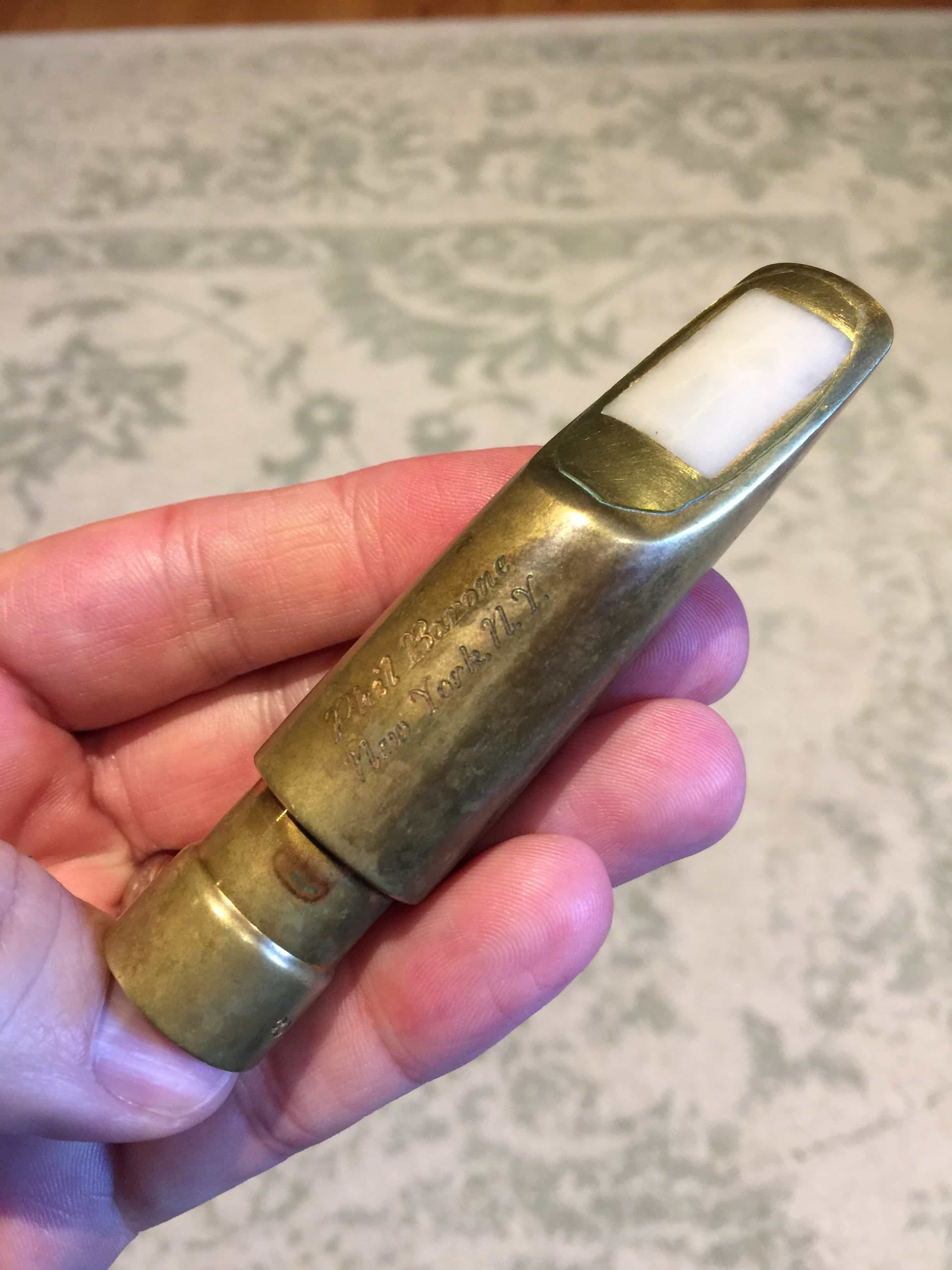
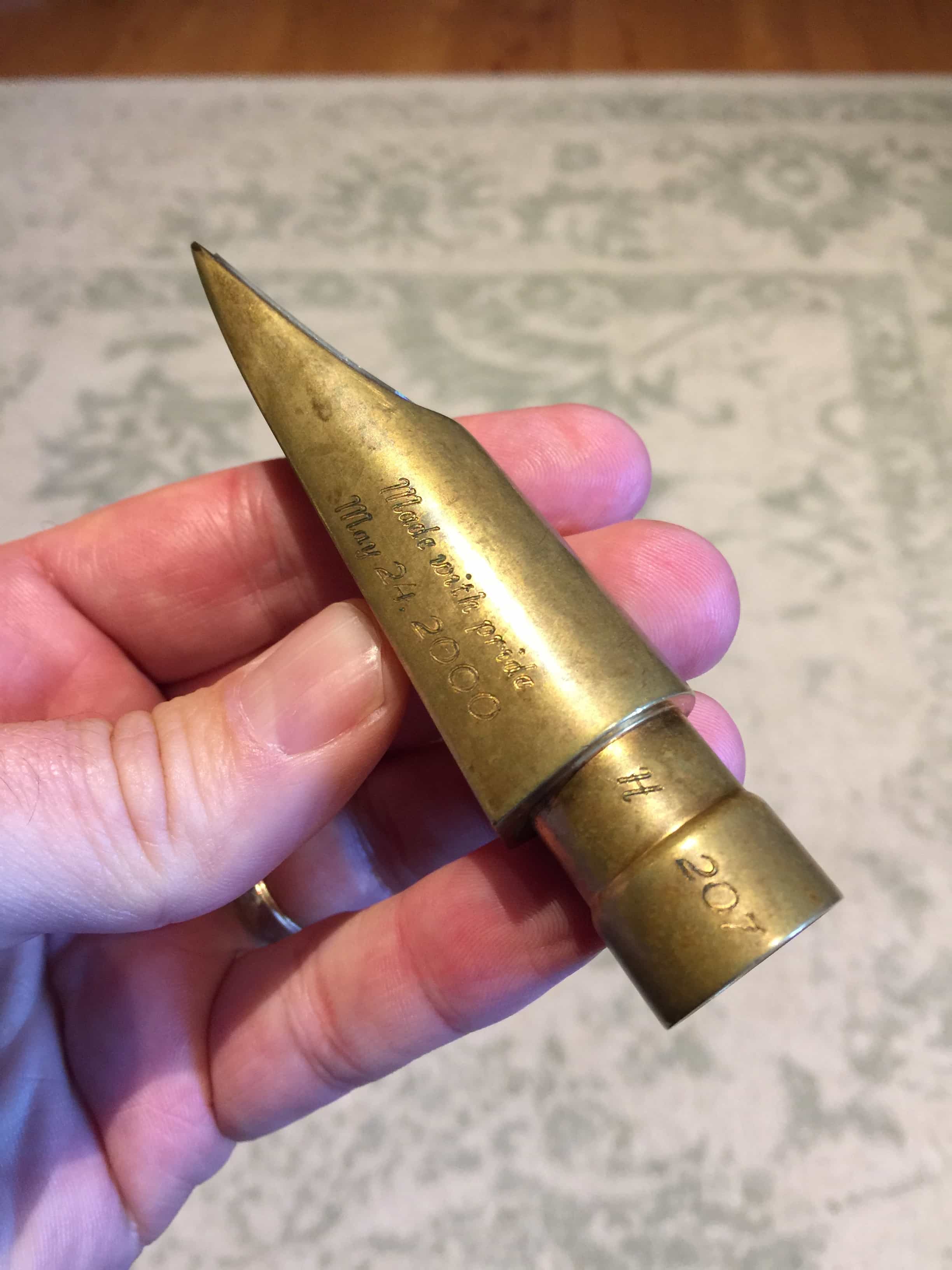
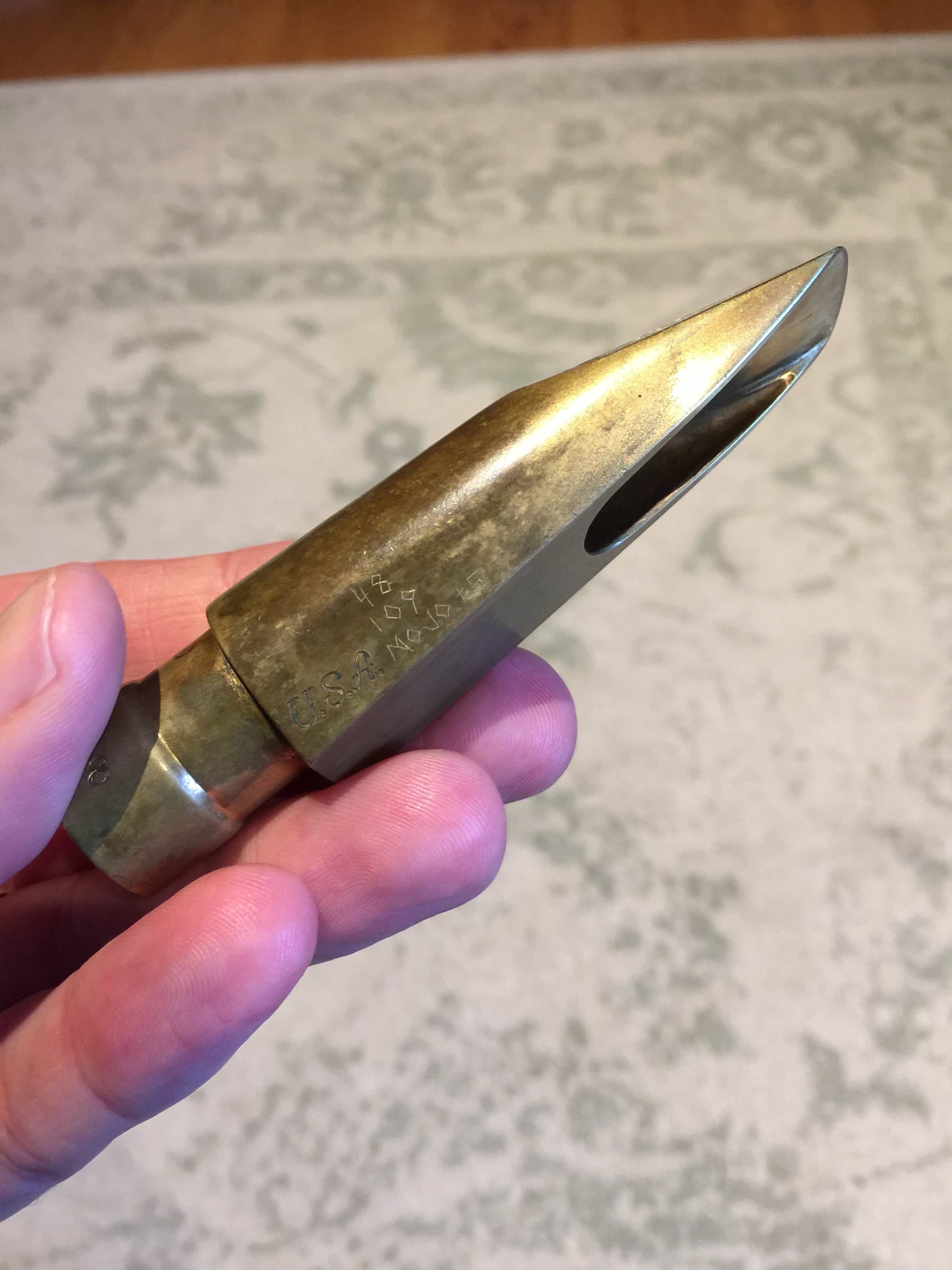
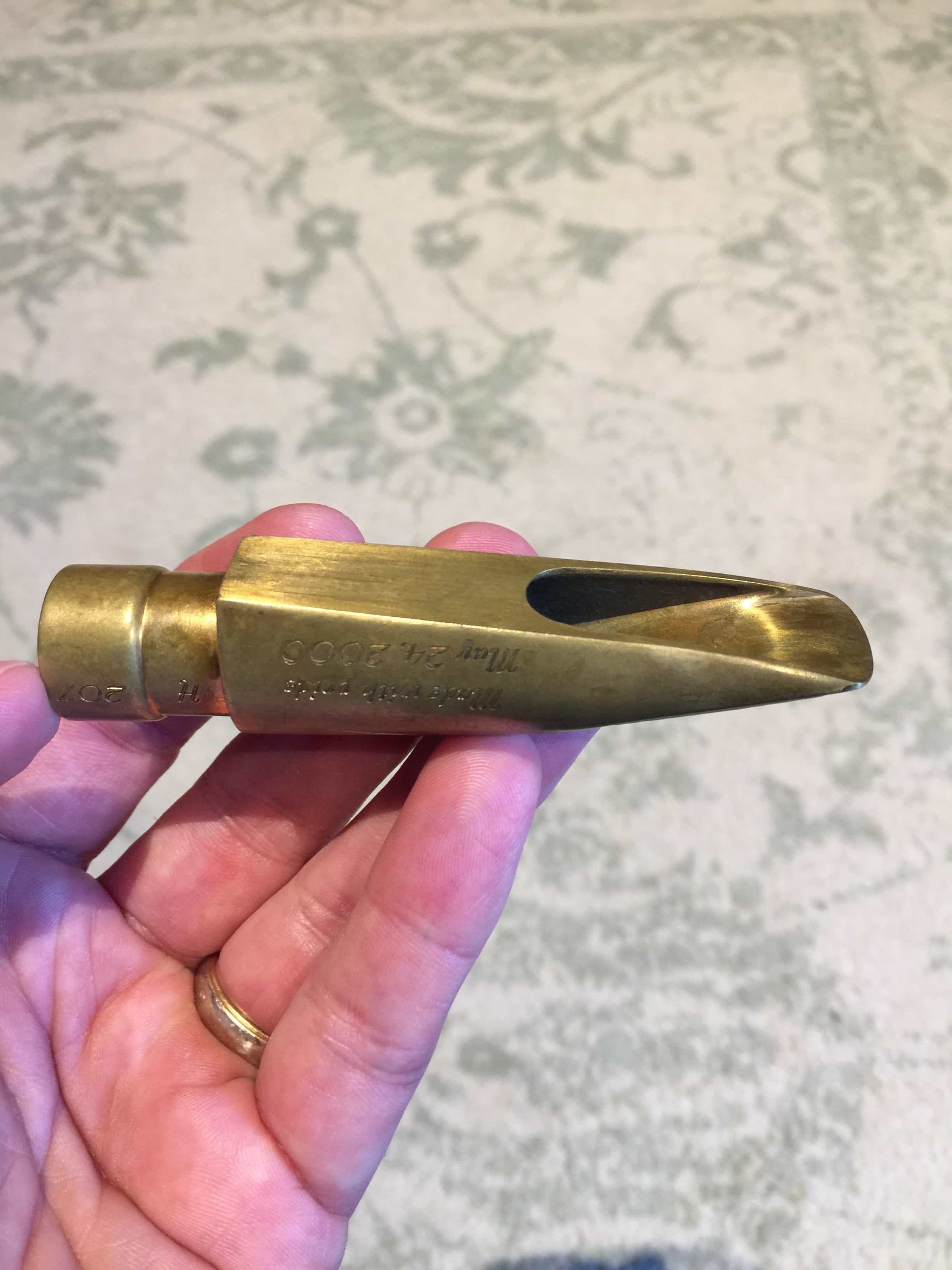
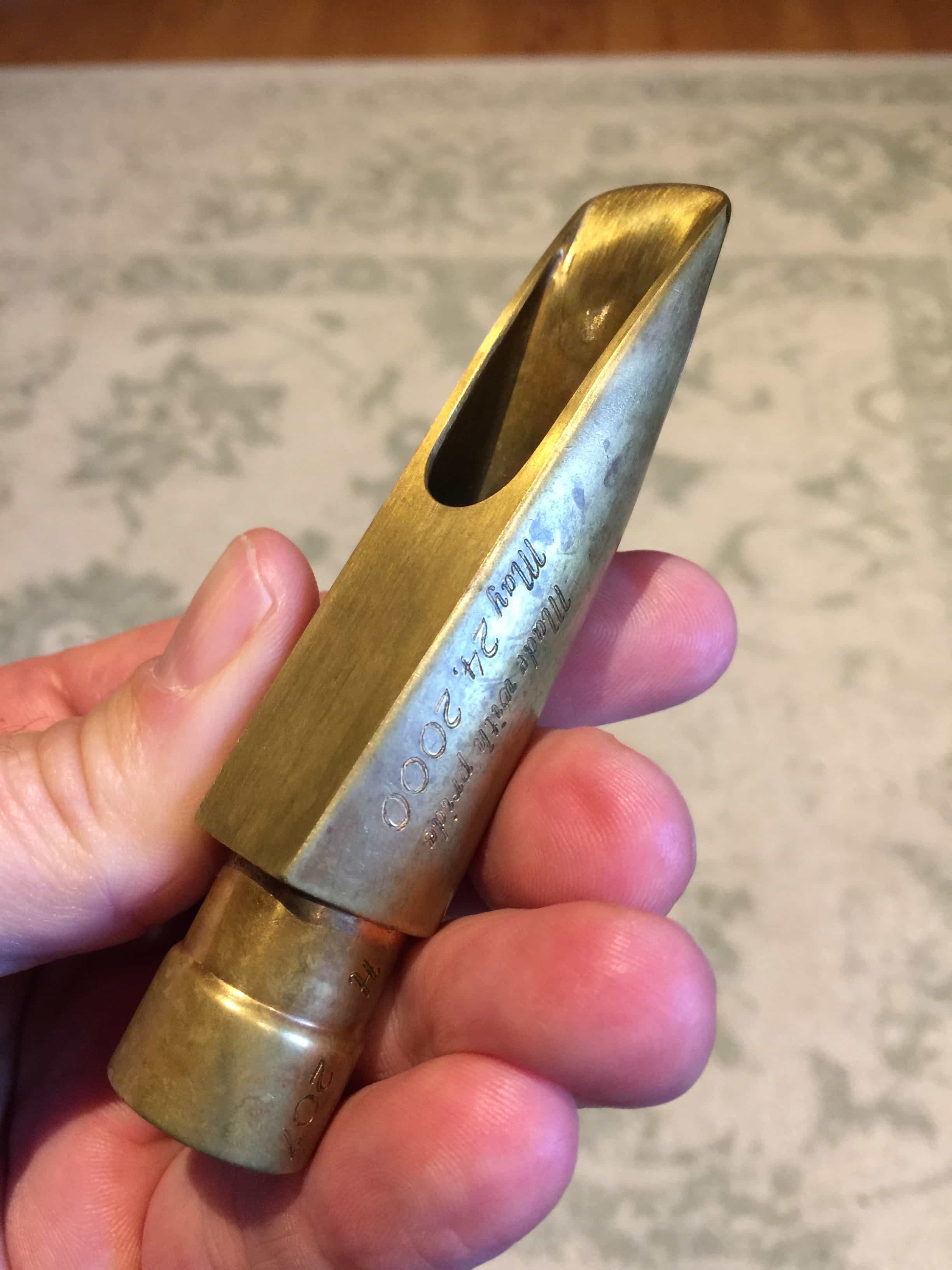





Since this was ~500 mouthpieces ago for me, I had to pull up my records to see what was done. Steve sent me some facing numbers for a JVW mouthpiece that he had. I don’t know if they were supplied to him by JVW or someone else. But I did not measure the facing using my gauges. I fit an elliptical facing curve through this data. It had a significant hump in the curve 9-12 mm from the tip compared to a true eliipse. Was this a facing feature or a result of a different measured/set of gauges? I ended up choosing a target curve for the Barone that was a true ellipse that I thought would have a similar resistance to the data sent me. Maybe a little less without the odd hump in it. If I had measured the curve myself, I might have leaned towards copying it more exactly. But since I did not trust the numbers sent to me 100%, I thought it was best to supply a great facing curve near the numbers sent.
Keith, Yes, I remember that. I think I sent you 5 numbers for the curve and you usually work with 8 if I remember correctly. I got the original numbers from another mouthpiece refacer who measured it for me but for the life of me I can’t remember who did it. Maybe Brian Powell or Erik G but I am not sure. I am resistant to sending it out just because it is my only mouthpiece like that and I would be devastated to lose it…….
How did you get the numbers? Did you send it out?
Hi Keith, I just found an old email. I sent the JVW to Erik Greiffenhagen to have him measure it and try to copy it on an EB mouthpiece I had. This is what Erik said in an email after the EB was done: “also the curve is just a touch longer than the JVW which is a fairly steep acceleration out near the tip. with a curve of; 48/38/28/22/16/.108″ the EB is 48/38/28/23/16+/ .108” The difference with that EB was that it didn’t have a baffle close to the JVW so Erik had to put one in to try to match it. He came close to the JVW also but it blew slightly easier for me than the JVW as I remember.
That lump at 22 that was moved to 23 is the same lump I saw and did not care for copying.
The sound , dry and reverb, were Great! I loved the tone ,both great. Thank you Steve for all your hard work. Health an happiness to you and family .Anthony
The sound is great, definitely a subtle but noticeable Brecker-esq tone (= brightness / edge) to it while staying very musical and rich/complex. A great cross-over sound for those playing both jazz gigs as well as rock/R&B/blues gigs. It sounds/seems like with just a wee bit of pushing this thing would really scream and cut through a bigger, louder band mix, while playing lyrically and melodically at a lower to normal airflow/volume; is that a accurate assumption? How different is the sound you are now generating with it (tone-wise) vs. the original piece, before Keith’s work to it?
Hey Scott, I was just about to reply that I didn’t record with the Hollywood 8 before the reface but then checked my computer and found this sound clip I made of it when I got it and never posted. https://bit.ly/2UXdEEQ I guess I didn’t like it very much because I never posted it and then sent the mouthpiece out to get refaced. In my opinion, the original piece had too much resistance that caused some edginess in the sound that I didn’t like. Although it was really powerful, I felt like the tone was really midrange heavy to my ears. Not enough highs in the sound for my tastes. The shorter facing curve that Mojo put on allowed me to use a softer Java 2 1/2 reed which gives the tone more brightness and highs I think. If I used that reed on the original piece I think it would have felt like a wet noodle. I just listened to the sound clip and it was interesting to listen to. Let me know what you think and what differences you hear. It’s the same recording setup and mic although a different room as I had moved since then. Thanks for your insights and input. Steve
Perfect, wonderful, I like a lot!
Steve,
Thanks for sharing the “before” clip of the piece, and thanks especially for inviting me to take a listen and share a perspective about the comparison with you. In the interest of full disclosure: in addition to being a sax player, I also am a sound engineer (mostly “live” sound, only a bit of recording although I love both).
So I’ve given the “before” clip you shared several listens, then went back and listened to the “dry” post-Mojo clip above to best compare and contrast the two. Really interesting. Whatever Keith did, really opened up the sound of that Barone Hollywood mouthpiece a lot. The “before” clip was quite muffled and stifling to the tone – you can hear it in the midrange and low range of the horn, it’s almost like there’s a compressor on the mixer, or more accurately like someone put EQ cuts in the lower mid and lower frequency ranges. You can totally hear it on the clip. Really strange. Like there’s a wet blanket on the horn whenever you get to the middle of the horn and below. Which is really weird, as this is the typical “sweet spot” of any horn, where clarity and definition are best/highest and easiest to attain. Contrarily, the higher frequency ranges seem unaffected and possibly even enhanced or magnified a bit on the “before” clip. What I also heard in the “before” clip was this: about half way through (at just over a minute in, I can really hear it noticeably at 1:20 and on) you adjust your playing (probably your embouchure and/or your cheek and neck musculature and/or your blowing) and suddenly that muddy muffle-ness is much less noticeable (although still there). The sound pops out a bit more and the horn sounds more full, although still lacking in the low-end and midrange. So, good on you for hearing that “mid-flight” and making those adjustments to make it sound better – the sign of a true pro player. I’d be interested in hearing your perspective on that – do you remember making those adjustments while recording it way back then? If so, what do you remember adjusting? Just curious…
Now comes the sensitive part: I both agree and disagree with your assessment on the “before” part of the sound, in this way: Agree, that there is a definite edge to the sound, but disagree with you on where that’s centered/focused around, frequency-wise – it’s clearly in the high end. There’s a ton of high end brightness and edge on the “before”, and a lot less midrange, and almost zero low end, giving the piece almost no warmth and no depth of color or richness in the sound produced “pre-Mojo”. The post-Mojo “after” sound is altogether different – the low end and midrange are nice and full, showing more depth and richness and texture (although you play very little in the low end on the clip, what you did play sounds almost “fat” and buzzy, which is a total transformation from the “before” clip).
I noticed that, in your initial announcement of each clip, that you were using 2 different reeds (although both were 2 1/2’s) to record the “before” and “after”. That could’ve also made a difference and impacted the resultant sound/tone to the recordings as well, obviously. Different reed makers call their strengths/stiffnesses something that seems “standard” like 2 1/2 or 3, but as we all know, there are no true standards and they often do not equate very comparably to other reed makers’ 2 1/2’s or 3’s for example. Of course that’s why the “Reed Charts” that are out there are so useful and handy…
Anyway, my general summation of what I heard on both was that, indeed, the Mojo work added a bit more definition to the high end/frequency range of the sound and tone, giving it a bit more structure and edge, but where I really heard the difference was in the midrange and low end tone. A huge (and positive) difference!
Scott, Thanks for the great feedback. I don’t remember making the clip at all. I didn’t even know I had it until I did a search on my computer. I’m not a sound guy in the least so my terms probably aren’t matching up with yours. When I hear a sound that is muffled, stifling and like a wet towel as you put it, my first thought is that it is midrange heavy. I guess I feel those things when I’m listening to music and turn down the highs. The sound gets all muddy, heavy and thuddy sounding. It lacks any cripness in the sound and clarity. When I heard the before clip that is what I thought of. It’s weird because I hear edge in it but not the crisp sizzle of those highs that I hear in the Mojo refaced clip. I also didn’t listen to it in comparison to the Mojo clip either so you are way ahead of me.(I hate listening to myself so try to do it as little as possible…..) I appreciate your time and input though. This stuff fascinates me. For every guy like you that hears large differences I get another guy that emails me and says the clips sound all the same so……….. Steve
Steve, I really appreciate your comments, lessons, and opinions of the different mouthpieces. As a professional musician, I can appreciate your expertise in explaining the different results of trying different mouthpieces and your personal results. I would like to send you one of my pieces to try (but return it), to see if your results are in the same ball park as mine. I think I could use my backup piece in the meantime. Please let me know if this is possible. Actually, I’m would like to go smaller than my tenor OT 8*, but getting better results throughout the horn. So far this is the best all around setup for me. Thanking you in advance.
Hi Nick, Unfortunately, I’ll have to pass on your offer. I get many emails from players asking me if I could try their mouthpieces but I just don’t have the time to do that. I’m glad you like the site and find it helpful. Thanks, Steve
PS. I also don’t try mouthpieces that aren’t for sale. The last thing a sax player wants to do is try a killer mouthpiece that isn’t for sale and then have to send it back. I’ve had to do that in the past and it was a real bummer……..
Steve, I have a Hollywood that is only one serial number off from yours and it is also way too tight, is the shank too thin after the fix ? My tech was worried it wouldn’t fare so well when I asked if he could taper it a bit
No, Mojobari did a great job on it. I didn’t notice it was too thin when I got it back. Steve
Great sound has this Barone. But why you didn’t give to Phil to reface it? That’s his baby after all :)))))
I got the impression Phil was pretty much out of that line of work around that time.